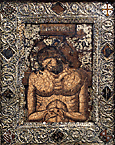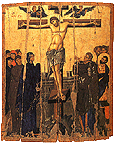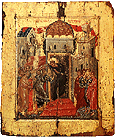 |
|
 |
Icons
 he art of making small mosaic icons flourished particularly
he art of making small mosaic icons flourished particularly
 between 1280 and about 1320. The superb technique and the elegance of the design of the more than 30 surviving examples of icons still impress us today. This type of icon, already known since the 12th century, acquires during the Palaiologan period new characteristics, making the icons resemble works of minor art, since the multicoloured tesserae of coloured glass and precious stones are usually only the size of a pinhead. between 1280 and about 1320. The superb technique and the elegance of the design of the more than 30 surviving examples of icons still impress us today. This type of icon, already known since the 12th century, acquires during the Palaiologan period new characteristics, making the icons resemble works of minor art, since the multicoloured tesserae of coloured glass and precious stones are usually only the size of a pinhead. As in earlier times, the painting of icons in the 14th century followed the style of monumental art. One of the masterpieces of the time is found today in the Byzantine Museum in Athens. It is the icon of the Archangel Michael, which
 is dated to the middle of the 14th century. The exquisite quality and the style of this icon, reminiscent of the frescoes of the Chora monastery, relate it to Constantinople. Similarly, the icon of the Crucifixion from Monemvasia, also in the Byzantine Museum, resembles the wall paintings in the neighbouring churches of Mistra such as those in the monastery of the Virgin Peribleptos. Finally, of great interest are two icons from the monastery of the Great Meteoron (or of the Transfiguration), offerings is dated to the middle of the 14th century. The exquisite quality and the style of this icon, reminiscent of the frescoes of the Chora monastery, relate it to Constantinople. Similarly, the icon of the Crucifixion from Monemvasia, also in the Byzantine Museum, resembles the wall paintings in the neighbouring churches of Mistra such as those in the monastery of the Virgin Peribleptos. Finally, of great interest are two icons from the monastery of the Great Meteoron (or of the Transfiguration), offerings
 of Maria Angelina Palaiologina and her husband Thomas Preljubovic, despotes of Ioannina (1367-1384). In the first icon Angelina is portrayed kneeling at the feet of the Virgin, who is shown standing and holding the Christ Child in her arms. This is a very common formula for the portrayal of donors. On the other hand, a second icon showing her among the disciples of Christ in the scene of the Doubting of Thomas, constitutes a very original and bold conception, indicating the new personal relationship in the communication with the Divine that seems to have developed during the troubled years of the Late Byzantine Period. These icons, attributed to workshops of Ioannina, attest to the development of the art of icon painting in places other than the large artistic centres of the Empire. of Maria Angelina Palaiologina and her husband Thomas Preljubovic, despotes of Ioannina (1367-1384). In the first icon Angelina is portrayed kneeling at the feet of the Virgin, who is shown standing and holding the Christ Child in her arms. This is a very common formula for the portrayal of donors. On the other hand, a second icon showing her among the disciples of Christ in the scene of the Doubting of Thomas, constitutes a very original and bold conception, indicating the new personal relationship in the communication with the Divine that seems to have developed during the troubled years of the Late Byzantine Period. These icons, attributed to workshops of Ioannina, attest to the development of the art of icon painting in places other than the large artistic centres of the Empire.
See also: Chora monastery
|